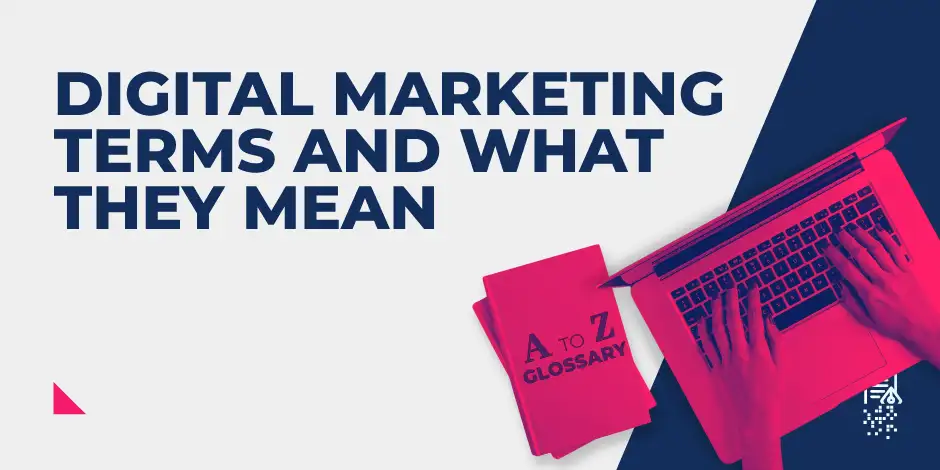

Digital Marketing Terms and What They Mean
We’re all pros when it comes to terms like ‘engagement metrics,’ ‘black-hat SEO’, and ‘SERP.’
Or are we?
If you don’t already work in digital marketing, you’d be totally forgiven for not being familiar with these marketing terms. Given that they’re so specific to the industry, for most people, at least some digital marketing words and phrases will probably be entirely new to you. While others you may have already seen crop up from time to time, especially if you like to keep up with what’s going on at Reboot.
That’s why we’ve decided to create a glossary of digital marketing terms, so you can gain more confidence in your knowledge of at least some of the most common marketing jargon.
Though we’ve put these terms in categories relating to different branches of digital marketing, do bear in mind that these phrases can often overlap and be relevant to more than one area.

Photo credit: Rafal Olechowski/ Shutterstock
SEO Related Terms
SEO is an acronym for Search Engine Optimisation. This is the use of specific methods that will help your website rank highly on search engines, such as Google. This is a key component of marketing, with some digital marketing companies making SEO the focus of their business.
Algorithm
In an SEO context, algorithm refers to the way by which search engines rank pages on the SERP.
Black Hat SEO
Black hat SEO is an attempt to manipulate a site’s position in the SERP by making a webpage appear more relevant to its users than it actually is. Some examples of black hat SEO are; keyword stuffing, using unrelated keywords and inserting hidden text.
E-A-T
This stands for Expertise, Authoritativeness and Trustworthiness. A site with a higher E-A-T will be seen by Google as a better quality site than one with a lower E-A-T.
Google Search Console
Google Search Console (GSC for short) is an online platform from Google that helps users optimise their website and keep track of its performance.
Google Webmaster Guidelines
Another helpful tool from Google is the webmaster guidelines. These outline best practices for SEO.
Keywords
These specific words and phrases will lead people to your site or web page. Using low competition keywords with high search volumes on your site will help your content rank higher on search engines. To carry out keyword research, you can use platforms such as Ahrefs and SEMRush which will help you tailor your content to search engines and, in turn, increase visitors.
Keyword Stuffing
Keyword stuffing refers to the overuse of keywords in content, metatags or backlinks. This is usually done in order to increase the ranking of a certain page or site on the SERP. Google can easily identify when keyword stuffing has taken place and penalise a page that does this by lowering its position on the SERP or removing the page entirely.
Long-Tail Keywords
These are longer and more specific keywords.
Search Query
Also known as a search term, a search query is a word or string of words that a person will use when looking for particular content on a search engine.
SERP
SERP is an acronym for ‘Search Engine Results Page,’ think of it as what comes up when you search for something online. The higher up on the SERP, the more likely people are to see your website or webpage.
Short tail keywords
This refers to shorter, more broad keywords.
White hat SEO
The opposite of black hat SEO, white hat SEO refers to search engine optimisation techniques that follow search engine rules. Generally, white hat SEO puts the experience of human site users before search engines.
Analytics Terms
Whether your focus is social media or website content, you’ll want to know how well your content is performing. This can be done by using analytics.

Abandonment rate
This refers to the rate at which site visitors begin and then stop the process of carrying out a conversion. For example, someone filling an online shopping cart without completing the transaction.
Authority
Based on factors such as website traffic and shares on social media, a site’s authority refers to its popularity.
Bounce rate
This is the amount of users that land on a webpage, only to leave without looking at any other pages on a site. A high bounce rate will negatively impact a site’s place on the SERP.
Click-through rate (CTR)
The click-through rate is the amount of people that click on a piece of content compared to the amount of people that see it (impressions) on the SERP. If, for example, your blog post has an impression rate of 100, and five people click on the link, the CTR will be 5%.
Conversion rate
This refers to the amount of people that carry out an action you want a user to complete, compared to the total number of page visitors. For example, if you have 100 users on your page and three users buy a product, sign up for a service or fill in a form, the conversion rate would be 3%.
Engagement metrics
This refers to how often, and in which ways, your site users engage with your content. It includes metrics such as bounce rate, page visits, shares on social media etc.
Google analytics
Google Analytics is a tool from Google that allows users to analyse how well their content is performing.
Impressions
This refers to the number of people that see a piece of content, such as an advertisement.
Organic traffic
The amount of visits to your site through unpaid search results.
Pageviews
The amount of visitors to a page.
Sessions
A session refers to how long a user interacts with your site.
Website Creation and Maintenance Terms
If you’re interested or involved in digital marketing, you’ll possibly be involved in creating or maintaining your company's website. If so, it’s recommended that you familiarise yourself with the following terms.

Accessibility
In the context of digital marketing, accessibility means making your website or other online content usable for as many people as possible. This can refer to both the ways in which people may access the site (e.g. via mobile), as well as considering those who may struggle with disabilities.
Alt text
Alt-text is the text used to describe an image. This is particularly helpful for those with visual impairments.
Anchor text
This is text that, when clicked on, sends the user to a different webpage.
Call to action
A call to action, also known as a CTA, is a call for the user to perform a certain action on your site. For example, ‘sign up here,’ ‘contact us,’ or ‘buy now.’
Content management system (CMS)
This refers to a system that allows users to build and edit web content. An example of a CMS is WordPress.
External links
An external link is a clickable link that will take the user to a page on a different website than your own.
Internal links
Internal links are similar to external links, however, clicking on these will take the user elsewhere on the same site.
Landing page
This is the page a person will land on when clicking a link to your website.
Meta description
A description of a webpage that isn’t visible on the site itself, but does appear on the SERP. They should be between 50 to 160 characters.
Meta title
This is the name of the webpage, which can be seen on the SERP. It should be no more than 70 characters.
Content Marketing Terms
Content marketing refers to any content that’s used when marketing a brand, product or service. This can range from videos, emails, blogs, and so much more. With content creation being a key component of any marketing campaign, you may find it useful to run through these common content marketing terms.

Evergreen
Content that is evergreen refers to content that won’t go out of date. For example, posting content about a current event in the news will not be considered evergreen.
Infographic
An infographic is an image showing data in a digestible way that’s easy to understand.
Newsjacking
Newsjacking is when a brand carries out a campaign that ties into a topical news story.
Persona
A persona is the type of person you are creating content for. This can include metrics such as gender, age, location etc.
Proofreading
Proofreading is a really important part of the content writing process. Once a piece of content has been written, it should be thoroughly checked for any errors before posting.